Course:FNH200/2014w Team04 BabyFood
Introduction
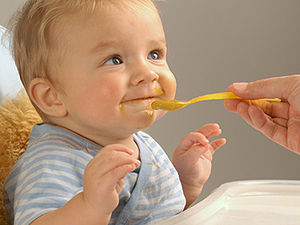
At different stages of baby development, infants require different types of baby food (i.e. from liquid to semi-solid). This is due to their different nutrient requirements at different stages. In general, there are 3 main stages of baby development − infants (up to 6 months), baby (6-12 months) and toddler (1 to 4 years).[1] Similarly, there are 3 stages of food for the stages of baby development − Stage 1 food, Stage 2 food and Stage 3 food. [2] Stage 1 food is mainly for child of 4-6 months and would be mostly puree of vegetables and fruits).[1] They are usually single ingredients food and provide a chance for infants to try out new food. Stage 2 food is for child of 6 months or above and include purees of mixed vegetable and meat as well as some grains).[1] The food would be more variable and introduce more solid forms. Stage 3 food is for 8-9 months or older and include chunky vegetables and fruits paste or sauce as well as some cereals.[1] In our project, we will be focusing more on stage 1 food (4-6 months) and look into their ingredients, packaging, labellings, health benefits, safety issues and vice versa.
History
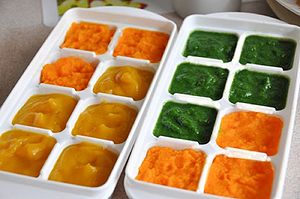
Up until the 19th century, industrialized countries produced baby food in their own homes. How? Recipes often deemed suitable for infants were found in regular cookbooks. For example, foods considered very nutritious and were easily digestible was considered "baby food." There is no doubt that semi-liquid foods exist in almost all cultures. For example, congee can be considered a liquid-like food in Asian culture, as it is easily digestible and mushy. Many scientists believe that manufactured baby food was a by-product of the European Industrial Revolution, but it wasn't until the 1920s when baby food production officially began.[3] Below is a short time line:
- 1920s: cereals, fruits and veggies, and other convenient items were created. It took some time for marketing strategies to work, but fast forward to today, baby food is extremely popular among consumers! Note: Baby food was often associated with a lot of controversy because it often resulted in deaths among babies.[3]
- Canada: in 1931, the baby food brand Pablum was available in Canada (and the US). It was an infant cereal that was rich with vitamins and other health benefits for infants, therefore, it became very popular. Today, Pablum continues to be a well-known infant food![3]
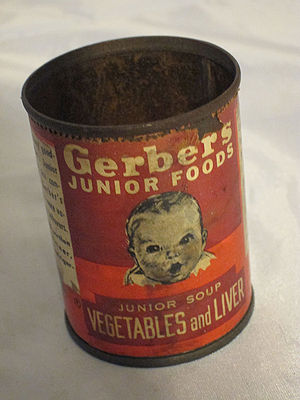
Canning was the first method of preserving food in the late 18th century[4], so undoubtedly canning baby food is the most wide-spread and recognizable method used.
Some popular brands that have been producing baby food for a long time and continue to dominant in the baby food industry: Heinz, Nestle (also known as Gerber), and Earth's Best.
Ingredients
Main Ingredients
The ingredients in baby food are what make it the quintessential “healthy food”. Containing simple, limited, well-rounded and overall nutritious ingredients, baby foods are a complete, easy and live-able diet. This time frame of a baby’s life consists of a tonne of fruits, vegetables and meats without all of the unnecessary added sugars, salts or preservatives that many pre-made adult foods contain. Here is a breakdown of the most commonly found ingredients in commercial and homemade baby foods today.
Fruits
Many baby food manufacturers add fruits to their food to be a good source of dietary fiber, vitamins, and natural sugar, but also taste, colour, texture and aroma. Many fruits can be, and are, used in baby foods; as long as it can be pureed, it is used. Some of the most popular fruits include: apples, bananas, peaches, and strawberries. Their popularity is attributed to not only their taste, but also the natural vitamins and minerals they provide, and the consistency that they form once pureed. [5]
Vegetables
Vegetables are also a main ingredient in baby foods due to their high levels of vitamins and minerals, and dietary fibre while generally lacking in simple sugars. The most popular vegetables to use in baby foods are the ones that are a little higher in fats and starches, and create a pleasant and easy to eat texture when pureed. For those reasons, some of the most popular vegetables used in baby foods include: avocado, peas, beans, squash, yams, carrots or spinach. [6]
Meats
In the past, meats were not recommended for babies less than a year old, but recently pediatricians have started recommending getting babies to eat meat earlier and earlier. [7]When used in baby foods, meats should never be ‘rare’ or have any pink, uncooked regions left in them. Introducing meats earlier helps babies have proper protein levels, and also naturally provides babies with zinc and iron (specifically ‘meat iron’ or ‘heme iron’ which is only found in animal meat and is more readily absorbed by humans than vegetable iron is[8].) The meats that are often found in baby foods are: poultry, beef, lamb, and some fish. [9]
Other Ingredients
- Ascorbic Acid: added to maintain the colour of the pureed fruits. It is also added to increase the vitamin C content of the food. Humans are unable to produce Vitamin C and can only get it through eating. For baby foods, majority of the time there is only one ingredient, and if that food doesn't have Vitamin C then they are not absorbing any of this vitamin which is necessary for proper health and nutrition. This is another reason why ascorbic acid is added to baby foods. [10] [11]
- Citric Acid: added to act as a preservative (due to its acidic pH controlling bacterial growth) and also as a flavour enhancer, creating and enhancing fresh, tart flavours. Citric acid is also added to help with the breakdown and absorption of certain vitamins and minerals. [12]
- Fruit Juice Concentrates: concentrates are just fruit juice with majority of the water removed; added for flavour, not for nutritional value. Concentrated juices and purees should not come before whole fruits or vegetables on the ingredient list. [13]
- Tapioca Starch: Tapioca Starch is added as a thickening agent and sweetener. It is popular because it is a gluten free option and has a relatively low cost. [14] [15]
Organic vs Conventional?
Many parents have the belief that organic baby food is superior to non-organic ones in terms of nutrients as well as quality. Indeed, organic baby food would have lower pesticide levels than non-organic ones since organic farming prohibit the use of pesticides and use natural pest control methods. [16] There are studies showing that exposure to pesticides in a young age may lead to increased vulnerability to health problems such as neurological disorders in the future. [17][18] Also, brain development are rapid and crucial in baby so what they eat would certainly affect their development. Therefore, organic baby food may be a better choice for parents in terms of body development. However, the nutrient levels of organic food are proven to be more or less the same as conventional ones.[19] This indicates that organic baby food is not necessarily more nutritious than the non-organic ones. Besides, the ingredients are important as well. Some organic baby food may still put artificial ingredients instead of real ones and this would decrease the nutrient levels of the food.[18] Since the price of organic baby food are often higher than non- organic ones, parents should consider carefully and do not purchase organic baby food blindly.
Processing
Processing Methods
There are several processing methods used to sterilize and process puree baby food in order to kill the pathogenic and spoilage-causing microorganisms in it, including:[20]
- Conventional sterilization
- Electric heating (e.g. microwave heating, high frequency heating)
- High pressure processing
- Irradiation
- and more....
Criteria of choosing processing methods for baby food
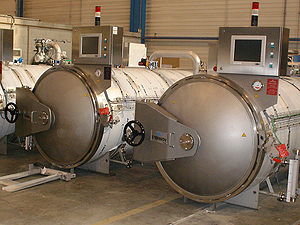
Microbiological Safety
Since babies/infants do not have their immune system developed completely in early ages, they are very sensitive to microorganisms, no matter the good or bad ones. Therefore, it is very important that the food they consume has very low levels of pathogenic microorganisms in order to prevent them getting sick.[20] From a microbiological aspect, thermal processing would be the safest to sterilize purees. When purees undergo commercial sterilization, if they are treated properly and carefully with the right amount of sterilization time, it is possible to kill most of the pathogenic microorganisms (i.e. spores, bacteria) in them.[21] This ensures the food is safe for infants to eat. Also, depends on the packaging chosen for the heat-sterilized puree, if they are stored in a can or pouches, they will be shelf-stable and will not have significant microbe growth for months.[21] On the other hand, if the purees are treated with freezing or refrigeration, the pathogenic microorganisms are just inactivated and could recover and resume their growth once the food is placed in room temperature. [21]This may be a little unsafe for the infants if the food require defrosting since improper defrost could lead to huge growth of microorganisms.
Nutritional Quality
Baby food is the major food source for the infants other than infant formulas/breast milk. Therefore, the nutrients in the food must be retained as much as possible to provide the best nutrition to the babies. From the nutritional quality aspect, freezing may be a better way to preserve baby purees. During freezing, the food will not be heated so it does not expose the nutrients (i.e. vitamins, minerals) to heat and experience nutrient degradation.[22] It also retain the food's colour and texture so the food quality can be maintained. Compared to heat-sterilized purees, infants can receive higher levels of nutrients and better quality from the frozen ones and benefit their health.
Some words on processing...
It is really difficult to find a processing method that can satisfy all of the criteria. Some manufacturers may consider microbial growth as a more important aspect than nutrient degradation so they may prefer using commercial sterilization. Trade-off between nutritional quality and microbiological safety must be done and perhaps mixed processing methods should be used to obtain the optimal quality baby food.
Homemade VS Industrial
Homemade
Home canned foods have a higher risk of botulism, therefore, some do not recommend canning baby food. Botulism spores can germinate rapidly in anaerobic conditions such as homemade canned food. For example, some bacterias/contaminants such as Clostridium botulinum can grow in low acidic environments, and in the absence of dissolved oxygen, so they grow best anaerobically. [21] This is also why high acidic foods (ie: tomatoes, fruits) are best for canning. Low-acid foods (ie: vegetables, dairy products) require high temperature processing, so using something like a pressure canner would be ideal to safely can baby food. Pressure canning has a high enough temperature to destroy heat resistant spores before they can become vegetative.[23] According to a new study in the Journal of Food Science called High-Pressure Thermal Sterilization: Food Safety and Food Quality of Baby Food Puree (Sevenich et al.), processing baby food with high-pressure thermal sterilization (HPTS) will reduce the amount of furan, acrylamide, HMF, and MCPD-esters. This is due to shorter exposure times and a lower thermal load applied to the product. Another positive aspect is that it will reduce the loss of desirable properties in the food (ie: vitamins). It also has more safety and quality benefits. According to the study, the amount of furan was reduced between 81%-96% in comparison to retorting.[24]
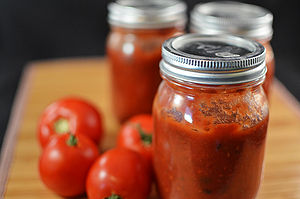
Industrial
Commercially canned products undergo rigid thermal processes that make it difficult, if not impossible, for botulism to occur. Therefore, the only reason for one to be concerned about industrially packaged products is if the packaging is swelling, punctured, or dented. Otherwise, in terms of which process would have the least chance of microbial growth, industrial products can be considered safer than home canning (only because in home canning, factors such as using the wrong temperature or using improper sanitary methods are more likely than commercially canned products, which have safety standards - not to mention it is their job to ensure that food is processed and packaged safely for child consumption). [25]
Packaging
Glass Jars
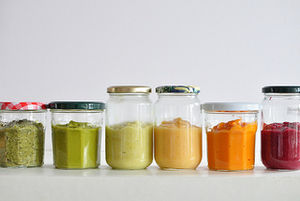
Glass jars have been a traditional method to pack baby food and it is still used by most manufacturers nowadays. Most parents consider glass jars as more fancy and also they can observe the food quality by eye easily. [26]These glass jars are sanitized and the processed puree are placed inside and sealed.[27] After that, the whole jar is being cooked at high heat for a certain amount of time to kill the pathogenic and spoilage-causing microorganisms. Baby food in glass jars have a shelf life of 1 year with refrigeration.[28][27] The taste and nutritional quality are mostly preserved but some of the flavor may be compromised and lost.[27] Also, the jars are quite heavy and need extra care in processing as well as after consumption. In processing, the jars may break due to the thermal shock in the retorts.[27] After consumption, if the jars drops, especially when baby is handling it, the broken glass pieces may cause injuries.
Pouches
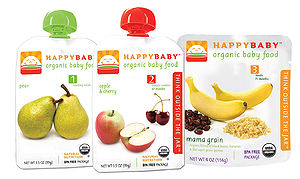
Better technology and new inventions change the trends of packaging for baby food. There are 2 kinds of pouches − one with resealable zipper and the other with twist-tops. [28]They are similar in terms of their function and the material they are made out of. Pouches are usually composed of thin layers of aluminum and laminated plastics such as polyester, foil, nylon and polypropylene. [29][27] They are more portable and much lighter than glass since they are made of plastic. It is relatively more convenient and safe for parents to carry it around. It also does not require a long heating process due to the thinner surface materials.[30] It takes 25% to 40% less retort time than glass jars in the same temperature and still sterilize the products properly. [28]This results in better preservation of nutritional quality, taste and freshness in the products.[30] Moreover, the pouches usually have greater visual effects compared to glass jars and plastic containers due to the better printing surfaces. It can have more varieties in designs and colors on the packages which attracts the babies more and arouse their interests in eating. [31] For the resealable ones, they are convenient because when there are leftovers, you can always zip and use it later. On the other hand, the ones with twist-tops does not require any cutlery and the baby can just squeeze by hand and sucks the puree from the small opening [31]Babies may find it more fun as well when eating the puree by themselves.
Plastic containers
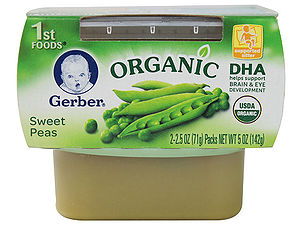
Manufacturers considered plastic containers as a great alternate for glass jars due to the flexibility plastic provides. After sterilizing the purees, the pre-sanitizied plastic containers will be filled with these purees.[27] These containers tend to have thinner walls than glass jars. It is lighter which benefits both the consumers and manufacturers.[30] For consumers which is the parents in this case, it is easier for them to bring and carry around for their children. For manufacturers, lighter products reduce their transportation cost as well as reduce incidents of breakage and leakage. [32] Besides, some of these plastic containers are microwavable which makes it really easy for parents to reheat it. [32]
Overall, different packaging methods provide different advantages and disadvantages. Manufacturers choose the methods according to different factors (i.e. cost, physical characteristics of the food, consumer's convenience) and try to find the best one to get the best outcome out of the food.
Labelling Requirements
Definitions:
- Infant - A person who is under the age of one year [B.25.001, FDR].[33]
- Infant food - A food that is represented for consumption by infants [B.25.001, FDR].[33]
- Human Milk Substitute (or Infant Formula) - A food that is represented for use as a partial or total replacement for human milk and intended for consumption by infants, or for use as an ingredient in a food that is represented for use as a partial or total replacement for human milk and intended for consumption by infants [B.25.001, FDR].[33]
- NEW Human Milk Substitute (or Infant Formula) - A human milk substitute that is manufactured for the first time, sold in Canada for the first time, or manufactured by a person who manufactures it for the first time [B.25.001, FDR].[33]
Infant FOOD
Age claim on infant foods: the age group the food is intended for must be on the packaging. For example, both baby foods we examined fall into the 6+ months range, also commonly known as the beginner stage. The CFIA prohibits labeling formulas for infants under 6 months because it is recommended that they do not begin eating solids until at least their 6 months old. As shown in in Parent's Choice fruit formula, the company has listed it as "Beginner", whereas Heinz put "6+ months."[33]
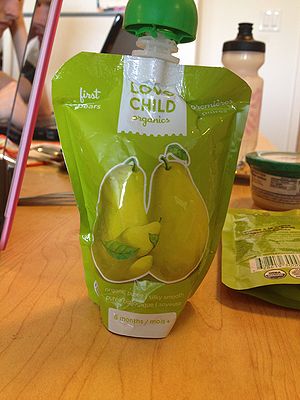
Voluntary claims and statements for infant formula: According to the Specific Nutrient Content Claims Requirements website, claims that are allowed for children under 2 years old include:
- Source of protein";[34]
- "Excellent source of protein";[34]
- "More protein";[34]
- "No added sodium" (or salt); and[34]
- "No added sugars"[34]
Also, under the Nutrient Function Claims for Children Under Two Years of Age, the following should NOT be labeled on foods:
- A factor in normal early fetal development, and
- A factor in the normal early development of the fetal brain and spinal cord.[35]
For a more in-depth definition of what this means please refer to: Acceptable Nutrient Function Claims Table
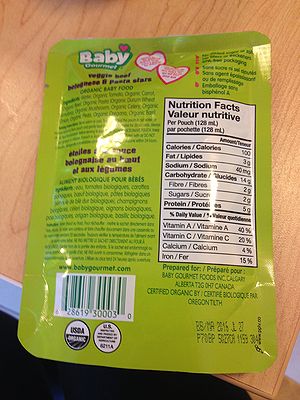
Nutrition Labelling for Infant Foods There are very specific labeling requirements for baby food under 2 years of age. The type of labelling will depend on various factors such as: format of packaging and usage. The type of labelling on the baby products is Standard/Horizontal/Linear Formats – for Children Under Two Years of Age (see picture 1.1 for example). This is one of the most common forms of labelling, and can be used for most products.[33] The usage of this product must comply with the guidelines below:
- Prepackaged product containing assortment of similar foods, where 1) serving consists of only one of the foods, and 2) information for serving size, energy and core nutrients is the same for all individual items.[33]
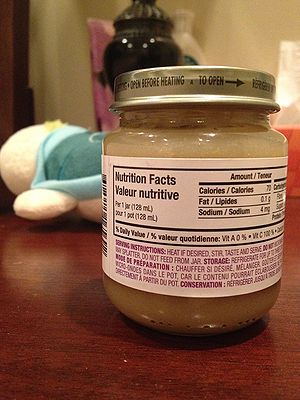
Other formats include: Simplified & Aggregate Formats.
Sodium Restrictions Only a certain amount of sodium is permitted in baby food. Below are the exact guidelines for infant food:
- B.25.002. No person shall sell or advertise for sale an infant food that is set out in Column I of an item of Table I to this Division and contains more than the amount of sodium set out in Column II of that item.
- B.25.003. (1) Subject to subsection (2), no person shall sell infant food that contains
(a) strained fruit, (b) fruit juice, (c) fruit drink, or (d) cereal, if sodium chloride has been added to that food. (2) Subsection (1) does not apply to strained desserts containing any of the foods mentioned in paragraphs (1)(a) to (d).[36]
Infant FORMULA
- Common Name: must be "infant formula" for any human milk substitutes. CFIA defines human milk substitutes as "A food that is represented for use as a partial or total replacement for human milk and intended for consumption by infants, or for use as an ingredient in a food that is represented for use as a partial or total replacement for human milk and intended for consumption by infants (under 1 year old) ." [37]
- Expiry date: Must be labeled on it because it has been specially manufactured to meet the requirements of a specific person. Infant formula falls into this category, therefore, an expiration date must be labeled on the packaging.[38]
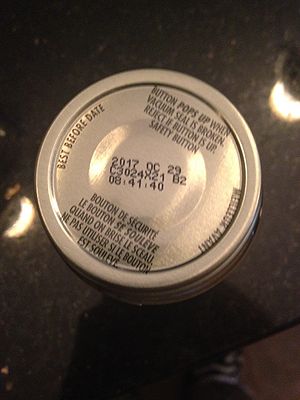
Expiry date shown on a jar of baby food - List of ingredients for infants
- Infant formula pre-market notification: Any new baby food that is being sold for the first time in Canada must submit their label to Health Canada for approval, also known as pre-market notification.[37]
- Directions for preparation, use, and storage: must have all required instructions for preparation, and proper storage (after container is opened). [37]
- Statement for foods represented as containing infant formula: must show the proportion of infant formula present in the food "in close proximity and in equal prominence to any claim regarding the presence of the infant formula in the food."[37]
- Nutrition Labelling: labels are not allowed to use the Nutrition Facts table heading (ie: "Nutrition Facts"), with the exception of order of presentation, naming of nutrients, fonts, layout, etc. as long as the requirements listed in Division 25 (example below) are met. A suggested heading is: "Nutrition Info." Division 25: the interpretation list in B.25.001 is very extensive, but it pertains to interpretation behind terms such as "expiration date." This means that companies have to follow these guidelines in respect to the product. For example "expiration date" guidelines are below:[37]
“expiration date” means, in respect of a human milk substitute, the date • (a) after which the manufacturer does not recommend that it be consumed, and • (b) up to which it maintains its microbiological and physical stability and the nutrient content declared on the label.[39]
Other terms such as "junior, infant, major change, and new human substitute" can be found here on the Canadian Foods and Regulations website: Division 25
- Nutrient Content Declaration As shown directly on the Canada Inspection website, the label of infant formula and foods that are represented as containing infant formula must declare per 100 grams or 100 milliliters as sold and per stated quantity when ready to serve: the content of protein, fat, available carbohydrate, ash, and when present, crude fibre, in grams; the energy value in Calories; the amount of vitamins and mineral nutrients listed in table II to Division 25 in International Units or milligrams; and the content of choline and any added nutritive substance normally contained in human milk (e.g., nucleotides, docosahexaenoic acid [DHA] and arachidonic acid [ARA]) in grams or milligrams [B.25.057, FDR].
The label of foods that are represented as containing infant formula must also declare per 100 grams or 100 millilitres of the infant formula portion of the food as offered for sale: the content of protein, fat, available carbohydrate, ash, and when present, crude fibre, in grams; the energy value in Calories; the amount of vitamins and mineral nutrients listed in table II to Division 25 in International Units or milligrams; and the content of choline and any added nutritive substance normally contained in human milk (e.g., nucleotides, DHA and ARA) in grams or milligrams [B.25.057, FDR].[37]
- Compliance of Nutrient Content Declarations: Specific rules about variance, tolerance, and rounding rules can be found on the Nutrition Labelling - Foods for Special Dietary Use
- Nutrient Content Claims: Claims ALLOWED on Foods Intended Solely for Children Under Two Years of Age include: "source of protein";
"excellent source of protein"; "more protein"; "no added sodium" (or salt); and "no added sugars".[40] If any starch is used in the product, it must also be listed. For vitamin and mineral daily intakes, certain amount are allowed for each vitamin.
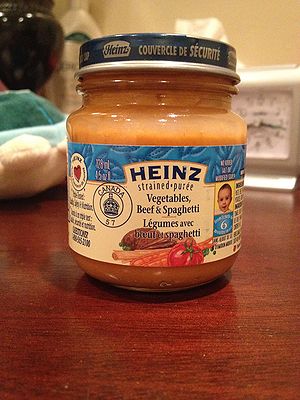
For example, the daily recommended daily intake (RDI) for Vitamin A is <400g. More in-depth information can be found on the Recommended Daily Intake - Infants
Here is a list of what is NOT allowed on the label of infant formula relating to the percent (%) daily value content in the food from:
- fat,
- saturated fatty acids and trans fatty acids,
- sodium,
- potassium,
- carbohydrate,
- fibre, or cholesterol;
or the number of Calories from:
- fat, or saturated fatty acids and trans fatty acids.[41]
- Iron Content Claims and Infant Formula: Other than identifying the quantity of iron on the label, it is prohibited to make a claim with respect to the iron content of an infant formula unless it contains at least 1 mg of iron per 100 available Calories [B.25.058, FDR]. [41]
- Representations Pertaining to the Presence of Specific Fatty Acids: Information pertaining to specific fatty acids in infant formula is allowed. For example, these may be used to differentiate infant formula with and without added sources of the long chain fatty acids, docosahexaenoic acid (DHA) and arachidonic acid (ARA), the addition of which is not mandatory. [41]
Example (from CFIA Nutrient Content Claims): the statement "with added DHA (an omega-3 fatty acid) and ARA (an omega-6 fatty acid)" would be acceptable. However, since all infant formulas are required to contain linoleic acid, an omega-6 fatty acid, and alpha-linolenic acid, an omega-3 fatty acid, it is important that statements regarding the content of "omega-3" and " omega-6" fatty acids do not imply that DHA and ARA are the only omega-3 and omega-6 fatty acids in an infant formula.
- Easy to Digest Claims on Infant Formula: the food must be demonstrated to be digestible, acceptable, and provide good nutrition for infants. All "easy to digest" claims apply to all infant formulas. The "easy digest" claim should be based on all/multiple aspects of the digestive process relevant to infants. Because infant formula has strict rules, it is subject to pre-market assessment by the Food Directorate of Health Canada. More info can be found in Conditions for Use for Function Claims.
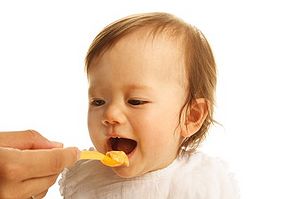
Baby eating "easily digestible" food
- References to Breast-milk: Must show the appropriate use of an infant formula while promoting breastfeeding.
Risks Associated with Improper or Contaminated Packaging
Despite the drastic measures that take place during the packaging of food, sometimes harmful microorganisms can still become present. There are multiple ways in which food can deteriorate or become contaminated.
Type of packaging used
- Glass jars: more susceptible to damage, for example when dropped, glass may shatter
- Tetra Paks: can become punctured
- Plastic: can become punctured
Shelf life: Extension or Shortening
- Temperature: excessive heat will kill microorganisms, but also result in nutrient deterioration, as well as vitamin loss.
- Light: can encourage oxidative deterioration
- Moisture gain or loss: can lead to food deterioration because of the change in water activity. Moisture may provide a favourable environment for microbial growth, and chemical and enzymatic reactions will take place.
- Oxygen: oxidative reactions, leading to loss in nutritive value, loss of colour pigmentation, and overall appeal and quality of food.
- Time: all foods deteriorate over time eventually
Insects and Rodents
- Infestation, especially with tetra paks or plastic packaging, due to puncturing or improperly sealed products
Microorganisms
- Improper cooking, heating, storage
Physical/mechanical damage
- Punctured packaging
- Swelling
- Rusting
- Leakage
- Denting
Acidity
- High acid foods (pH <4.6) will inhibit microorganism growth better than low acid foods. [21]
Botulism
According to the Public Health Agency of Canada, botulism is defined as an illness in which the nervous system is targeted due to a bacterium called Clostridium botulinum. [42] This bacterium thrives in moist areas with no oxygen, which is especially ideal considering canning provides the proper conditions for growth. Foods or beverages can become contaminated with this highly dangerous toxin and may be found in:
- Food that has been home-canned [42]
- Food with low acid content (eg. Beets, corn) [42]
- Honey, which should not be consumed by infants under the age of 1 [42]
- Improperly canned commercial foods
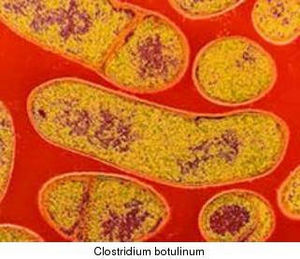
C.botulism
Foodborne botulism should not be taken lightly, especially with infants in mind. The incubation period for infants can take place anywhere around 3-30 days.[43] Symptoms include vomiting, dizziness, headache, and double vision, to name a few. The more serious symptoms are respiratory failure, paralysis, heart failure and death, although it is not as common.[44]
Cases of Recalled Baby Food
1) Heinz Canada conducted a voluntary recall involving baby food products that might have been contaminated with microorganisms due to a possible packaging defect. The products were packaged in pouches. Flavours included:
Peas zucchini spinach, sweet baby vegetables, beef Bolognese with vegetables, beef butternut squash rice spinach, tuna sweet corn chowder, and butternut squash apricot peas couscous.
The recall/advisory date occured on March 9th 2014 with a hazard classification of Class 3. The CFIA inspected the products triggered by a consumer complaint. [45] Heinz Canada then recalled the products from the marketplace. There were no other reported illnesses caused by the following products. [46]
2) June 2, 2011 there was a Class 1 recall from Heinz Canada. There was no worry about the possibility of microbial growth, but the CFIA warned consumers of a deformity in the glass jars that could have broken off and would have become a safety hazard. According to the photo provided, there seems to have been a dent along the side of container that could have broken if hit by accident. Any tiny pieces of glass could have then been consumed by a child. [47]
Risks Associated with Home-Canning and Necessary Safety Measures
Home Canning Safety
There are risks associated with homemade canning of baby food. It is necessary to keep the possibility of foodborne illness in mind. However, if home canning is the preferred option, below are the procedures and safety measures one can take to prevent microbial growth and ensure a safely consumable product.
Before you begin
Before filling the glass jars with food, it is important to check for damages such as dents, cracks or sharp edges that may be a safety hazard. Jars and lids should be cleaned and submerged in hot water until they are ready to use.[48]
Some important sanitary measures to keep in mind include:
- washing hands with soap and warm water before beginning, and in between stages of the canning process to avoid cross-contamination [49]
- washing fruits and vegetables[49]
- if dealing with meat, poultry, fish, etc. make sure they are on separate cutting boards and do not come into contact with each other, especially when dealing with fruits and vegetables.[49]
- sanitize countertops and appliances[49]
High vs Low Acid Food
High-acid foods, that is, food with a pH of less than 4.6 will require a boiling water canner. Because the food is naturally highly acidic, the acid will help prevent microbial growth, specifically clostridium botulinum, from being present. Food would then be heated to 100°C while the jars are completely submerged in the boiling water.[50] This in turn would kill most of the microorganisms.
Low-acid foods with a pH of over 4.6 require pressure canner cooking. This would include foods such as vegetables, tomato-based sauces, and asparagus to name a few. Heat processing at a temperature of 116°C is required. The reason why a boiling water canner would not work for low-acid foods is because water boils at 100°C, which is the maximum temperature that water canners can reach.[51] Acids such as lemon juice can be added as well in order to help with lowering the pH.[52]
It is good to note that cooling jars in a cool, dark, and dry place is beneficial as a strong vacuum seal will develop.[53] Also, home canned foods should be labelled and dated to minimize the risk of consumption at a date past the shelf life.
If these steps are followed, the risk of botulism can be eliminated and home canning can be enjoyed!
Health
Nutritional Needs of Babies[54][55]
| Nutrient | Function | Found in | Daily Dose |
|---|---|---|---|
| Iron | 1) Production of hemoglobin 2) Helps with brain development including motor skills and memory | Red meat, chicken, fish, eggs, avocado, broccoli and spinach | 11mg a day[56] |
| Calcium | 1) Developing strong bones and teeth 2) Promoting nerve and muscle function 3) Helping blood clot 4) Activating enzymes to convert food into energy | Milk, yogurt and cheese | 700mg a day[57] |
| Zinc | 1) Growth 2) Digestion and metabolism 3) Fuel for the production of infection fighting white blood cells | Meat and dark meat poultry | 3mg a day[58] |
| Essential Fatty Acids | 1) Regulate the nervous system 2) Strengthen the cardiovascular system 3) Build immunity 4) Help the body absorb nutrients. 5) Promotion of brain function and vision | Avocado and Salmon | 7g of Omega-6 a day and 700mg of Omega-3 a day[59] |
| Magnesium | 1) Keeping bones strong 2) Keeping steady heart rhythm 3) Build immunity 4) Promoting nerve and muscle function | Nuts and legumes | 80mg a day[60] |
| Potassium | 1) Control of body's water balance, which helps maintain healthy blood pressure 2) Promoting muscle function 3) Keeping steady heart rhythm 3) Reducing the risk of kidney stones and osteoporosis | Fresh fruits, vegetables, milk, meat and cereals | 3g a day[61] |
| Vitamin A | 1) Promoting vision and bone growth 2) Protecting body from infections 3) Promoting health and growth of cells and tissues in the body, particularly those in the hair, nails, and skin. | Colourful fruits and vegetables | 300mcg a day[62] |
| Vitamin C | 1) Formation and repair of red blood cells, bones, and tissues 2) Maintaining healthy gums 3) Strengthening blood vessels 3) Promote blood clots 4) Build immune system 5) Helps absorb iron. | Fruits | 15mg a day[63] |
| Vitamin D | 1) Absorbs calcium to build strong bones and teeth 2) Regulation of the immune system 3) Insulin production 4) Cell growth. | Sunshine, fish and eggs | 15mcg a day[64] |
| Vitamin E | 1) Promotes immune system and fights germs 2) Widen blood vessels for blood circulation to help the body work in many different important functions | Fruits, vegetables, nuts and seeds | 6mg a day[65] |
Conclusion
Trends and future
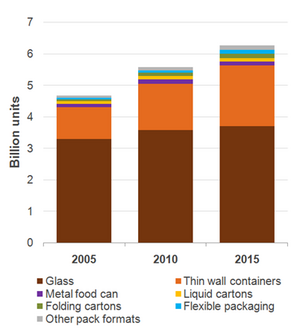
A fresh approach to baby food is turning cultural norms and some of the guidelines that experts have set. Rice, cereal and past have been dominating the diet of the babies in North America. While these aren’t bad, they lack some of the essential nutrients which sometimes leads to babies being picky with their food. [66]In terms of packaging, glass jars are still dominating the market currently but the trend may switch to pouches or more innovative ones in the future such that it can provide greater convenience to the parents and babies.
Babies in North America are being fed plain and tasteless mashed food. There is no research that proves the significant of this. It is only a cultural norm. More parents are now more open to the idea of food with spices and seasoning for their babies. [66]
Often, parents buy baby food at store because it is easy, convenient and supposedly healthy for babies, however, it may cause allergies in the later years and may even lead to cancer in extreme cases. Homemade baby food is attracting a lot of 'foodies'. [67] More parents are making their baby’s food on their own because every babies are different and it is more reliable and clean for them. [66]
Exam Review Question
1.
Q: Which factors of baby food and its production attribute to its general unpalatability to adults? (4 marks)
A: -Baby food must be very sensitive to allergies, therefore, they often include only 1 ingredient.
-Baby food preservation is usually accomplished by heat preservation, decreasing the quality of the food.
-Baby foods focus on nutrition instead of flavour, there, they usually lack sweeteners and other unnecessary flavour constituents commonly found in adult food
-Baby foods have been pureed as babies should not have any foods which could possibly be a choking hazard. This means all the appetizing textures of food have been destroyed.
2. Why do some people NOT recommend home-canning of baby food (in terms of Clostridium botulinum)?
A: Clostulinum bacterium thrives in moist areas with no oxygen, which is especially ideal considering canning provides the proper conditions for growth. Foods or beverages can become contaminated with this highly dangerous toxin and may be found in baby food. This risk also increases when at-home canning is improper. Some of the most serious symptoms such as respiratory failure, or even death may occur, but the chances are low.
Video Project
References
- ↑ 1.0 1.1 1.2 1.3 Heinz Baby, 2015 http://www.heinzbaby.com/en_ca/triple_tested_products/baby_food/1/
- ↑ Earth's Best Organic – Our Product, 2015 http://www.earthsbest.com/organic-baby-food/baby-food
- ↑ 3.0 3.1 3.2 Food Timeline FAQs: baby food, 2015 http://www.foodtimeline.org/foodbaby.html#pablum
- ↑ Lesson 01 - Food Science and the Canadian Food System, 2015 http://wiki.ubc.ca/Course:FNH200/Lesson_01
- ↑ USDA - Why is it important to eat fruits?, 2015 http://www.choosemyplate.gov/food-groups/fruits-why.html
- ↑ USDA - Why is it important to eat vegetables?, 2015 http://www.choosemyplate.gov/food-groups/vegetables-why.html
- ↑ Government of Canada - Infant Nutrition, 2015 http://www.healthycanadians.gc.ca/healthy-living-vie-saine/infant-care-soins-bebe/nutrition-alimentation-eng.php
- ↑ The Vegetarian Resource Group - Iron in the Vegan Diet, 2015 http://www.vrg.org/nutrition/iron.php
- ↑ USDA - Why is it important to make lean or low-fat choices from the Protein Foods Group?, 2015 http://www.choosemyplate.gov/food-groups/protein-foods-why.html
- ↑ Heinz Infant Allergens Baby Food, 2015 Retrieved from: http://www.heinzbaby.com/en_ca/useful_information/pdf/Heinz%20Infant%20Allergens%20Baby%20Food.pdf
- ↑ National Institutes of Health - Vitamin C, 2015 http://ods.od.nih.gov/factsheets/VitaminC-HealthProfessional/
- ↑ Moncel, B.(2015). What is Citric Acid? Retrieved from: http://foodreference.about.com/od/Food-Additives/a/What-Is-Citric-Acid.htm
- ↑ Food Juice Concentrate, 2015 http://www.fruitjuiceconcentrate.org/
- ↑ Smith, S. (2011) Tapping Into Tapioca Starch. Retrieved from: http://www.foodproductdesign.com/articles/2011/08/tapping-into-tapioca-starch.aspx
- ↑ U.S. Food and Drug Administration (1979). Dataset of Selection Committee on GRAS Substances(SCOGS) Reviews. Retrieved from: http://www.accessdata.fda.gov/scripts/fcn/fcnDetailNavigation.cfm?rpt=scogslisting&id=349
- ↑ Earth's Best Organics – Our Organic Food, 2015 http://www.earthsbest.com/why-earths-best/the-difference
- ↑ Jurewicz, J., Hanke, W., Johansson, C., Lundqvist, C., Ceccatelli, S., van den Hazel, P., . . . Zetterström, R. (2006). Adverse health effects of children's exposure to pesticides: What do we really know and what can be done about it. Acta Paediatrica (Oslo, Norway : 1992).Supplement, 95(453), 71-80
- ↑ 18.0 18.1 Organic vs Non-Organic Baby Food, 2015 http://www.livestrong.com/article/142602-organic-vs-non-organic-baby-food/
- ↑ Winter, C. K., & Davis, S. F. (2006). Organic foods. Journal of Food Science, 71(9), R117-R124.
- ↑ 20.0 20.1 Särkkä-Tirkkonen, M., Väisänen, H. M., Beck, A., Kretzschmar, U., & Seidel, K. (2010). Overview on different sterilization techniques for baby food. Retrieved from http://www.helsinki.fi/ruralia/julkaisut/pdf/reports60.pdf
- ↑ 21.0 21.1 21.2 21.3 21.4 Lesson 05 - Rational for Food Preservation, 2015 http://wiki.ubc.ca/Course:FNH200/Lesson_05
- ↑ Lesson 07 - Preservation of Foods By Low Temperature, 2015 http://wiki.ubc.ca/Course:FNH200/Lesson_07
- ↑ Momtastic's Wholesomebabyfood - Is canning homemade baby food safe?, 2015 http://wholesomebabyfood.momtastic.com/tipcanning.htm#.VRl29ZPF_3o
- ↑ Sevenich, R., Kleinstueck, E., Crews, C., Anderson, W., Pye, C., Riddellova, K., . . . Knorr, D. (2014). High‐Pressure thermal sterilization: Food safety and food quality of baby food puree. Journal of Food Science, 79(2), M230-M237. Retrieved from http://www.readcube.com/articles/10.1111%2F1750-3841.12345?r3_referer=wol&tracking_action=preview_click&show_checkout=&purchase_referrer=onlinelibrary.wiley.com&purchase_site_license=LICENSE_DENIED
- ↑ Buying canned or bottled products: Commercially canned products, 2015 http://healthycanadians.gc.ca/eating-nutrition/safety-salubrite/tips-conseils/food-canning-conserve-aliment-eng.php
- ↑ Chan, J. personal communication, 2015
- ↑ 27.0 27.1 27.2 27.3 27.4 27.5 Lesson 06 – Thermal Preservation of Food, 2015 http://wiki.ubc.ca/Course:FNH200/Lesson_06
- ↑ 28.0 28.1 28.2 What are the Different Types of Baby Food Packaging, 2015 http://www.wisegeek.com/what-are-the-different-types-of-baby-food-packaging.htm
- ↑ Connolly, K.B. (2011). Packaging Trends: Pouches Becoming Go-To Package Style For Broad Range of Products http://www.foodprocessing.com/articles/2011/pouch-packaging/
- ↑ 30.0 30.1 30.2 Brody, A. L. (2005). Packaging, Food. Kirk-Othmer Encyclopedia of Chemical Technology.
- ↑ 31.0 31.1 Packaging Insight : Spout Pouch For Baby Food Market, 2015 http://www.logospack.com.hk/knowledge_de.php?id=70
- ↑ 32.0 32.1 Baby food packaging: a shift from glass packaging to plastic packaging and pouches, 2011 http://blog.euromonitor.com/2011/03/baby-food-packaging-a-shift-from-glass-packaging-to-plastic-packaging-and-pouches.html
- ↑ 33.0 33.1 33.2 33.3 33.4 33.5 33.6 CFIA Labelling Requirements for Infant Foods and Infant Formula, 2015 http://www.inspection.gc.ca/food/labelling/food-labelling-for-industry/infant-foods-and-infant-formula/eng/1393069958870/1393070130128?chap=0#s13c4 Cite error: Invalid
<ref>tag; name "CFIA" defined multiple times with different content - ↑ 34.0 34.1 34.2 34.3 34.4 CFIA Nutrient Content Claims on Foods Intended Solely for Children Under Two Years of Age, 2015 http://www.inspection.gc.ca/food/labelling/food-labelling-for-industry/nutrient-content/children-under-two-years-of-age/eng/1389908330046/1389908390338
- ↑ CFIA Health Claims Children Under Two Years of Age, 2015 http://www.inspection.gc.ca/food/labelling/food-labelling-for-industry/health-claims/eng/1392834838383/1392834887794?chap=11
- ↑ Food and Drugs Regulation-Infant Foods, 2015 http://laws-lois.justice.gc.ca/eng/regulations/c.r.c.,_c._870/page-185.html#docCont
- ↑ 37.0 37.1 37.2 37.3 37.4 37.5 CFIA Labelling Requirements for Infant Foods and Infant Formula Definitions, 2015 http://www.inspection.gc.ca/food/labelling/food-labelling-for-industry/infant-foods-and-infant-formula/eng/1393069958870/1393070130128?chap=4#s11c4
- ↑ CFIA Date Markings and Storage Instructions Other Date Markings, 2015 http://www.inspection.gc.ca/food/labelling/food-labelling-for-industry/date-markings-and-storage-instructions/eng/1328032988308/1328034259857?chap=4#s10c4
- ↑ Food and Drug Regulations, 2015 http://laws-lois.justice.gc.ca/eng/regulations/c.r.c.,_c._870/page-184.html#docCont
- ↑ Nutrient Content Claims on Foods Intended Solely for Children Under Two Years of Age, 2015 http://www.inspection.gc.ca/food/labelling/food-labelling-for-industry/nutrient-content/children-under-two-years-of-age/eng/1389908330046/1389908390338
- ↑ 41.0 41.1 41.2 CFIA Labelling Requirements for Infant Foods and Infant Formula, 2015 http://www.inspection.gc.ca/food/labelling/food-labelling-for-industry/infant-foods-and-infant-formula/eng/1393069958870/1393070130128?chap=0#s9c3
- ↑ 42.0 42.1 42.2 42.3 Botulism: What Causes Foodborne Botulism?, 2012. http://phac-aspc.gc.ca/fs-sa/fs-fi/botulism-eng.php
- ↑ Botulism: Incubation Period, 2015 http://www.foodsafety.gov/poisoning/causes/bacteriaviruses/botulism/
- ↑ Home Canning Safety: Health Risks, 2013 http://healthycanadians.gc.ca/eating-nutrition/safety-salubrite/food-canning-conserve-aliment-eng.php
- ↑ CFIA - The Canadian Food Safety System: Food Recalls, 2015 http://www.inspection.gc.ca/about-the-cfia/newsroom/food-safety-system/food-recalls/eng/1332206599275/1332207914673
- ↑ CFIA Consumer Advisory - Certain Heinz brand infant food may contain packaging defects that may allow the entry of spoilage microorganisms, 2014 http://www.inspection.gc.ca/about-the-cfia/newsroom/food-recall-warnings/complete-listing/2014-03-09/eng/1394379805526/1394379825591
- ↑ Certain Heinz Strained Meat Baby Food Products have a glass deformity that could break off during normal use, 2011 http://healthycanadians.gc.ca/recall-alert-rappel-avis/inspection/2011/26941r-eng.php#!prettyPhoto
- ↑ Step by Step: Your Guide to Home Canning, 2011 http://www.bernardin.ca/pages/step_by_step___your_guide_to_home_canning/32.php
- ↑ 49.0 49.1 49.2 49.3 Home Canning Safety: Cleaning, 2013 http://healthycanadians.gc.ca/eating-nutrition/safety-salubrite/food-canning-conserve-aliment-eng.php#a8
- ↑ Preserving Food: Using Boiling Water Canners, 2011 http://nchfp.uga.edu/publications/uga/using_bw_canners.html, Andress, E. (2011rev.). Athens, GA: University of Georgia, Cooperative Extension.
- ↑ Low-Acid Foods, 2011 http://www.bernardin.ca/pages/low_acid_foods_introduction_/72.php
- ↑ Home Canning Safety: Cooking, 2013 http://healthycanadians.gc.ca/eating-nutrition/safety-salubrite/food-canning-conserve-aliment-eng.php#a8
- ↑ Introduction to Home Canning: Why is Heat Processing Important?, 2011 http://www.bernardin.ca/pages/why_is_heat_processing_important_/36.php
- ↑ What to Expect - Nutritional Needs of Babies, 2015 http://www.whattoexpect.com/first-year/nutritional-needs-for-babies.aspx
- ↑ Babycenter - 10 nutrients that every child needs, 2015 http://www.babycenter.com/0_10-nutrients-that-every-child-needs_1201019.bc
- ↑ Parenting - The 5 Nutrients All Babies Need, 2015 http://www.parenting.com/article/the-5-nutrients-all-babies-need
- ↑ Babycenter - Calcium in your child's diet, 2015 http://www.babycenter.com/0_calcium-in-your-childs-diet_10324689.bc
- ↑ Babycenter - Zinc in your child's diet, 2015 http://www.babycenter.com/0_zinc-in-your-childs-diet_10324698.bc
- ↑ Babycenter - Essential fatty acids in your child's diet, 2015 http://www.babycenter.com/0_essential-fatty-acids-in-your-childs-diet_10324690.bc
- ↑ Babycenter - Magnesium in your child's diet, 2015 http://www.babycenter.com/0_magnesium-in-your-childs-diet_10324694.bc
- ↑ Babycenter - Potassium in your child's diet, 2015 http://www.babycenter.com/0_potassium-in-your-childs-diet_10324692.bc
- ↑ Babycenter - Vitamin A in your child's diet, 2015 http://www.babycenter.com/0_vitamin-a-in-your-childs-diet_10324693.bc
- ↑ Babycenter - Vitamin C in your child's diet, 2015 http://www.babycenter.com/0_vitamin-c-in-your-childs-diet_10324695.bc
- ↑ Babycenter - Vitamin D in your child's diet, 2015 http://www.babycenter.com/0_vitamin-d-in-your-childs-diet_10324696.bc
- ↑ Babycenter - Vitamin E in your child's diet, 2015 http://www.babycenter.com/0_vitamin-e-in-your-childs-diet_10324697.bc
- ↑ 66.0 66.1 66.2 Babycenter - Baby food revolution: New rules for feeding your baby, 2015 http://www.babycenter.com/0_baby-food-revolution-new-rules-for-feeding-your-baby_10320504.bc?page=3
- ↑ Huffington Post - Homemade Baby Food: Feeding Future Foodies, 2014 http://www.huffingtonpost.com/gitanjali-roche/homemade-baby-food_b_5562733.html


